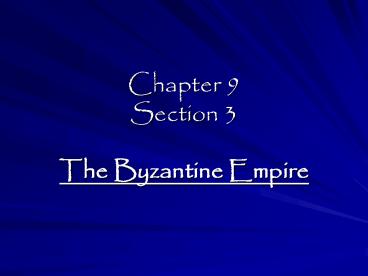Chapter 9 Section 3 - PowerPoint PPT Presentation
1 / 31
Title:
Chapter 9 Section 3
Description:
Chapter 9 Section 3 The Byzantine Empire Rise of the Byzantines The Greeks were the largest group of people in the empire, but there were many other peoples in the ... – PowerPoint PPT presentation
Number of Views:73
Avg rating:3.0/5.0
Title: Chapter 9 Section 3
1
Chapter 9 Section 3
- The Byzantine Empire
2
Rise of the Byzantines
- The Greeks were the largest group of people in
the empire, but there were many other peoples in
the empire as well. - These included Egyptians, Syrians, Arabs,
Armenians, Jews, Persians, Slavs, and Turks
3
Constantinople
- Constantines capital became the capital of the
Byzantine Empire - By AD 500s, Constantinople was thriving and one
of the worlds great cities.
4
Constantinoples Success
- Location, location, location! It lay on the
waterways between the Black Sea and the Aegean
Sea. The harbors offered a safe shelter for
fishing boats, trading ships, and warships.
5
Greek Influence
- Called the New Rome
- Emperors spoke Latin
- and enforced Roman
- law
- Hippodrome was
- where chariot races
- took place
- - Between AD 500 and AD 1200, the Byzantines were
one of the richest and advanced societies
6
Byzantine Empire AD 550
7
Emperor Justinian
- Justinian became emperor of the Byzantine Empire
in AD 527 and ruled until AD 565. - Strong ruler who controlled the military, made
laws, and was supreme judge.
8
Theodora
- Justinians wife helped him run empire
- For womens rights
- Helped Justinian keep his throne in AD 532 when
angry taxpayers stormed the palace
9
Justinians Conquests
- Wanted to reunite the Roman Empire and bring back
Romes glory. - He ordered a general named Belisarius to
strengthen and lead the Byzantine empire. - Their calvary, soldiers mounted on horses, were
successful in conquering most of Italy, northern
Africa, and defeated the Persians in the east.
10
Justinians Law Code
- Tribonian headed the group of legal scholars
ordered to reform the law code. - This new simplified code became known as the
Justinian Law Code. - Has influenced on laws of almost every country in
Europe since then
11
Byzantine Civilization
- Lasted about 1000 years.
- Most of the time, Constantinople was the richest
and largest city in Europe. - Byzantines were highly educated and creative
- Preserved the Greek culture and passed on Roman
law to other people
12
Importance of Trade
- Between AD 500s to the AD 1100s, the Byzantine
Empire was the center of trade between Europe and
Asia. - Most Byzantines were farmers, herders, laborers,
and artisans. - Weaving silk developed around AD 500 and was one
of the major industries
13
Byzantine Art and Architecture
- Constantinople was known for its hundreds of
churches and palaces. - Hagia Sophia Holy Wisdom was one of
Justinians greatest achievements.
14
Hagia Sophia
15
Hagia Sophia
16
Byzantine Art and Architecture
- Mosaics pictures made from many bits of colored
glass or stone - Important part of Byzantine life
- Typically depicted saints, which means Christian
holy people
17
Byzantine Women
- Family life was the center of the social life for
most Byzantines. - Byzantine women were not encouraged to lead
independent lives. - Regent a person who stands in for a ruler who
is too young or too ill to govern.
18
Byzantine Education
- Learning was highly respected
- Boys studied religion, medicine, law, arithmetic,
grammar, and other subjects. - Wealthy Byzantines sometimes hired tutors.
- Girls were usually taught at home
- Authors wrote about religion
19
Section 3Review
20
Section 3 Review
- What is the largest group of people that lived in
the Byzantine Empire? - Greeks
21
Section 3 Review
- What was the capital of the Byzantine Empire?
- Constantinople
22
Section 3 Review
- What was a major reason that Constantinople was
so successful? - Its location between the waterways of the Black
Sea and the Aegean Sea
23
Section 3
- What was another name for the Byzantine Empire?
Why was it called that? - It was called the New Rome because it was heavily
influenced by Roman ways.
24
Section 3
- Where did the Byzantine chariot races take place?
- The Hippodrome
25
Section 3 Review
- Was Justinian a good emperor? What were some of
his accomplishments? - He was a strong ruler who commanded the military
and ruled as a judge. He also built the Hagia
Sophia. He also reformed the law, which was then
called the Justinian Law Code.
26
Section 3 Review
- Who was Justinians wife? Why did she talk him
into remaining in the empire when the taxpayers
rebelled? - Theodora. She wanted to keep her title as
empress, and she thought her husband should show
them that he was a strong emperor.
27
Section 3 Review
- Who is Belisarius? How did he improve the
Byzantine army? - He is the general that Justinian ordered to
expand the empire. He changed the organization
from footed soldiers to calvary, which is
soldiers on horses.
28
Section 3 Review
- What is the Tribonian?
- Headed the group of legal scholars ordered to
reform the law code.
29
Section 3 Review
- What is the Hagia Sophia? What does it mean?
- A famous church that Justinian built that has
beautiful mosaics inside. It means Holy Wisdom.
30
Section 3 Review
- What is a mosaic?
- Pictures made from many bits of colored glass or
stone
31
Section 3 Review
- What is a regent?
- A person who stands in for a ruler who is too
young or too ill to govern































